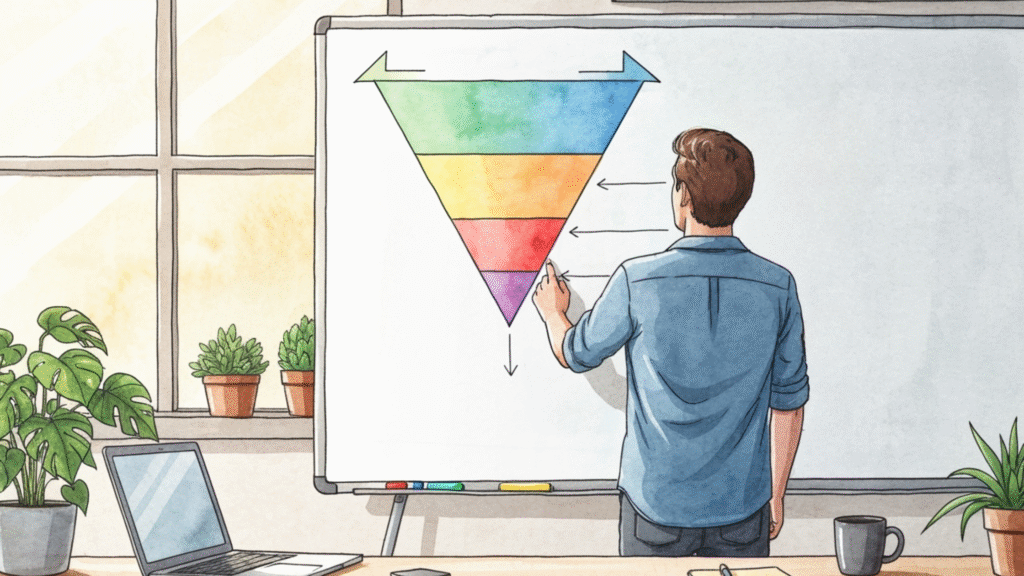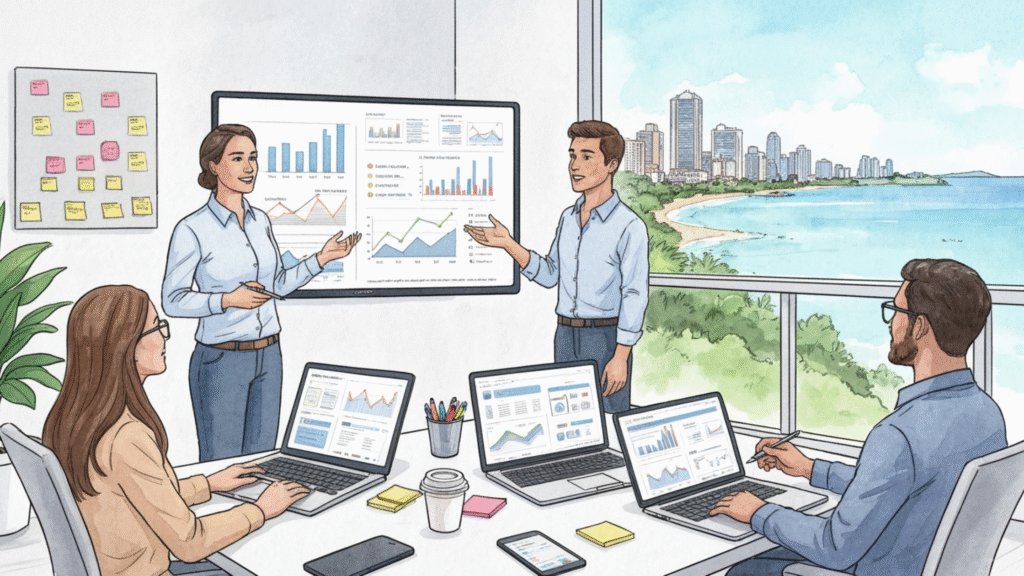In the competitive digital landscape of 2025, attracting visitors to your website is only half the battle. The real victory lies in transforming those visitors into valuable customers. This transformation does not happen by chance; it is the result of a meticulously designed and strategically executed lead generation funnel. A well-structured funnel guides potential customers through a series of stages, nurturing their interest and building trust until they are ready to make a purchase. For any business aiming for sustainable growth, understanding and optimizing each stage of this funnel is absolutely critical.
Think of your lead generation funnel as a carefully crafted journey. It is about understanding your audience’s needs at every step, providing relevant value, and gently guiding them towards a solution that you offer. This article will demystify the lead generation funnel, outlining its essential stages, providing actionable strategies for each, and highlighting the tools and techniques that will help you convert more visitors into loyal customers in 2025.
What is a Lead Generation Funnel?
A lead generation funnel is a multi-stage process designed to attract potential customers (leads), qualify their interest, nurture them with relevant information, and ultimately convert them into paying clients. It represents the journey a prospect takes from their initial awareness of your brand to becoming a satisfied customer.
While specific funnels might vary in complexity, they generally follow a progression from broad awareness to specific action:
- Awareness (Top of Funnel – TOFU): Attracting a wide audience and making them aware of your brand and the problem you solve.
- Interest/Engagement (Middle of Funnel – MOFU): Capturing contact information (generating leads) and engaging them with valuable content.
- Consideration/Desire (Middle of Funnel – MOFU): Further educating leads about your solutions and building their desire for your product or service.
- Conversion (Bottom of Funnel – BOFU): Guiding qualified leads to make a purchase or take a desired action.
- Retention/Advocacy (Post-Conversion): Turning customers into repeat buyers and brand advocates.
Understanding each stage allows you to tailor your marketing efforts, content, and communication to meet the prospect exactly where they are in their decision making process.
Stage 1: Awareness – Attracting Your Audience (TOFU)
The top of the funnel is all about casting a wide net to capture the attention of your target audience. At this stage, prospects may not even realize they have a problem or that a solution like yours exists. Your goal is to introduce your brand and the value you can provide.
Strategies for Building Awareness:
- Search Engine Optimization (SEO):
- Content Marketing: Create valuable blog posts, articles, and informational pages that answer common questions related to your industry or niche. Focus on informational keywords (e.g., “how to choose a web design agency,” “benefits of cloud computing for small businesses”).
- Keyword Research: Identify keywords your target audience is searching for at the awareness stage. Use tools like Google Keyword Planner or Semrush to find high volume, relevant terms.
- Technical SEO: Ensure your website is technically sound, fast loading, and mobile friendly so it can be easily discovered by search engines. Learn more about technical SEO best practices.
- Content Marketing:
- Blog Posts: Informative articles on industry trends, common problems, or how-to guides.
- Infographics: Visually appealing ways to present complex data or processes.
- Videos: Short, engaging videos on social media (e.g., TikTok, Instagram Reels).
- Podcasts: Offer interviews or discussions on topics relevant to your audience’s interests.
- Social Media Marketing:
- Organic Reach: Build a presence on platforms where your audience spends time (e.g., Facebook, Instagram, LinkedIn). Share valuable content, engage with comments, and run polls.
- Paid Social Advertising: Use targeted ads to reach specific demographics and interests. Platforms offer robust targeting options to put your content in front of the right people.
- Paid Advertising (PPC):
- Google Ads: Bid on broad keywords to capture users at the very beginning of their search journey.
- Display Ads: Use visual ads on websites and apps to build brand recognition.
- Public Relations (PR) & Media Mentions:
- Secure mentions in industry publications, local news outlets, or relevant online media to increase brand visibility and credibility.
Goal of Awareness Stage: Maximize reach and introduce your brand as a helpful resource.
Stage 2: Interest/Engagement – Capturing Leads (MOFU)
Once prospects are aware of your brand, the next step is to capture their interest and, crucially, their contact information. This is where visitors transition into leads. You offer something valuable in exchange for their email address or other contact details.
Strategies for Lead Capture:
- Lead Magnets (Opt-in Offers):
- Offer valuable, free resources that are highly relevant to your target audience’s needs and solve a specific problem.
- Examples: Ebooks, whitepapers, checklists, templates, exclusive guides, webinars, free consultations, discount codes, or free trials.
- Placement: Strategically place these offers on your website through landing pages, pop-ups, and content upgrades within blog posts.
- Compelling Landing Pages:
- Design dedicated landing pages for each lead magnet. These pages should have a clear headline, concise copy highlighting the offer’s benefits, and a prominent call to action (CTA).
- Minimize distractions: Remove navigation menus to keep visitors focused on the offer.
- Form Optimization: Keep lead capture forms short. Only ask for essential information (e.g., name and email). The more fields, the lower the conversion rate.
- Website Optimization:
- Clear CTAs: Place clear, action oriented calls to action throughout your website, guiding visitors to download your lead magnet or sign up for a newsletter.
- Pop-ups and Exit-Intent Overlays: Use these strategically to capture attention without being overly intrusive. An exit intent pop-up, for instance, appears just as a user is about to leave your site.
- Interactive Content:
- Quizzes and Assessments: Create quizzes that offer personalized results in exchange for an email address. For example, “What’s Your Marketing Funnel Weakness?” or “Find Your Ideal Vacation Spot.”
- Polls and Surveys: Engage users with questions and offer to send them the results if they provide their email. Learn more about engaging interactive content.
Goal of Interest/Engagement Stage: Convert anonymous visitors into identifiable leads by capturing their contact information.
Stage 3: Consideration/Desire – Nurturing Leads (MOFU)
At this stage, you have the lead’s contact information, and they have demonstrated interest. Your goal is to build trust, educate them further about your solution, and build their desire for your product or service. This is where you address their specific pain points and demonstrate how your offering is the best fit.
Strategies for Lead Nurturing:
- Email Marketing Campaigns:
- Drip Campaigns: Set up automated email sequences that deliver valuable content over time. These campaigns can be segmented based on the lead magnet they downloaded or their expressed interests.
- Personalization: Address leads by name, reference their previous interactions, and suggest content relevant to their specific needs.
- Educational Content: Send case studies, whitepapers, detailed product guides, testimonials, and answers to common objections. Focus on providing solutions and insights.
- Consistent Value: Do not just sell. Provide tips, industry updates, or exclusive content that keeps them engaged and reinforces your expertise. Refer to our DIY tips for engaging newsletters for inspiration.
- Webinars and Online Events:
- Host webinars that dive deeper into specific topics, offer live Q&A sessions, and showcase your expertise. These are excellent for interactive engagement and demonstrating value.
- Provide recordings of webinars to those who could not attend live.
- Retargeting Ads:
- Serve targeted ads to leads who have visited specific pages on your website or engaged with your content but have not yet converted. Remind them of your solution and special offers.
- Platforms like Google Ads and social media platforms offer robust retargeting capabilities.
- Personalized Content Delivery:
- Use marketing automation platforms to dynamically adjust the content a lead sees on your website or in emails based on their behavior (e.g., pages visited, content downloaded).
- Demonstrations and Trials:
- Offer personalized product demonstrations or extended free trials for your software or service. This allows leads to experience the value firsthand.
Goal of Consideration/Desire Stage: Build trust, educate leads about your solution’s benefits, and demonstrate its superiority.
Stage 4: Conversion – Turning Leads into Customers (BOFU)
This is the culmination of your funnel efforts. Qualified leads, who understand their problem and believe your solution is the best fit, are now ready to make a purchasing decision. Your goal here is to remove any final barriers and facilitate the sale.
Strategies for Conversion:
- Strong Calls to Action (CTAs):
- Make conversion CTAs very clear and prominent: “Buy Now,” “Schedule a Demo,” “Get a Quote,” “Sign Up for Free,” “Contact Sales.”
- Ensure the path to conversion is frictionless.
- Tailored Offers:
- Provide special incentives for highly qualified leads, such as limited time discounts, bundled packages, or exclusive bonuses.
- Offer different pricing tiers or service packages to cater to various needs and budgets.
- Social Proof and Testimonials:
- Feature compelling customer testimonials, case studies, and user reviews on your product or service pages. People trust the experiences of others.
- Display trust badges, security seals, and relevant certifications to reassure buyers.
- Sales Engagement:
- For B2B or High-Value B2C: Have your sales team directly follow up with highly qualified leads (e.g., those who requested a demo or completed a trial).
- Personalized Outreach: Sales reps should leverage all the information gathered through the funnel to tailor their conversations and address specific needs.
- Objection Handling: Be prepared to address any remaining doubts or objections transparently and effectively.
- Live Chat Support:
- Offer real time support on your website to answer last minute questions and guide prospects through the purchasing process. This can significantly reduce abandonment rates.
- Optimized Checkout Process:
- Ensure your checkout or sign up process is simple, secure, and intuitive. Minimize steps and distractions.
- Offer multiple payment options.
Goal of Conversion Stage: Facilitate the purchase and turn qualified leads into paying customers.
Stage 5: Retention and Advocacy – Building Loyalty (Post-Conversion)
The funnel does not end at conversion. Turning customers into repeat buyers and enthusiastic advocates is crucial for long term success and reduces the cost of acquiring new leads.
Strategies for Retention and Advocacy:
- Onboarding and Customer Success:
- Provide excellent onboarding experiences to ensure new customers quickly understand and maximize the value of your product or service.
- Offer ongoing customer support, tutorials, and resources to help them succeed.
- Loyalty Programs:
- Implement loyalty programs, rewards, or exclusive access for repeat customers.
- Offer special discounts on future purchases or upgrades.
- Email Marketing (Post-Purchase):
- Send thank you emails, order confirmations, shipping updates, and follow up emails to gather feedback.
- Share tips for getting the most out of their purchase, related product recommendations, or exclusive content.
- Solicit Reviews and Referrals:
- Encourage satisfied customers to leave reviews on Google, Yelp, or industry specific platforms. Positive reviews are a powerful form of E-A-T and attract new leads.
- Implement a referral program to incentivize existing customers to bring in new ones.
- Community Building:
- Create a community forum, Facebook group, or online space where customers can connect, share experiences, and get support.
- Host customer appreciation events or webinars.
- Feedback Loops:
- Regularly solicit customer feedback through surveys or direct communication. Use this feedback to improve your products, services, and overall customer experience.
Goal of Retention/Advocacy Stage: Foster customer loyalty, encourage repeat business, and generate positive word of mouth to fuel the top of the funnel.
Tools and Technologies for Your Lead Generation Funnel in 2025
Building an effective lead generation funnel often relies on the right mix of digital tools.
- CRM (Customer Relationship Management) Systems: Essential for managing lead information, tracking interactions, and segmenting your audience. Popular choices include HubSpot CRM (free version available) and Salesforce.
- Marketing Automation Platforms: Automate email sequences, lead scoring, and content delivery based on user behavior. Examples include ActiveCampaign, Mailchimp, and Pardot (Salesforce).
- Email Marketing Services: For sending newsletters and automated email campaigns. Mailchimp, Constant Contact, and ConvertKit are popular choices.
- Landing Page Builders: Tools to easily create high converting landing pages without coding. Examples include Unbounce, Leadpages, and sometimes built into marketing automation platforms.
- Website Analytics: Tools like Google Analytics provide insights into visitor behavior, traffic sources, and conversion paths, helping you identify funnel bottlenecks.
- SEO Tools: For keyword research, competitor analysis, and site auditing. Semrush, Ahrefs, and Moz are industry standards.
- Chatbot Platforms: For real time lead qualification and customer support on your website. Drift and Intercom are notable examples.
- Social Media Management Tools: For scheduling posts, monitoring engagement, and running ads. Hootsuite and Buffer are widely used.
When selecting tools, consider your budget, the complexity of your funnel, and the size of your team. Many tools offer free trials, allowing you to test them before committing.
Optimizing Your Funnel: Continuous Improvement
Building a lead generation funnel is not a one-time task. It requires continuous monitoring, testing, and optimization.
- Analyze Your Data: Regularly review metrics at each stage of your funnel. Where are visitors dropping off? What content performs best? What conversion rates are you achieving?
- A/B Testing: Experiment with different headlines, calls to action, form lengths, email subject lines, and landing page designs. Small changes can lead to significant improvements in conversion rates.
- Feedback Loops: Solicit feedback from both prospects (why they did not convert) and customers (what they liked or disliked). Your sales team also has valuable insights into common objections.
- Stay Agile: The digital marketing landscape is constantly changing. Be prepared to adapt your strategies, content, and tools based on new trends, algorithm updates, and evolving customer behavior.
- Personalization: As discussed with E-A-T, the more you can personalize the experience at each stage of the funnel, the more effective it will be. Use lead data to tailor messages and offers.
By committing to ongoing optimization, you can ensure your lead generation funnel remains a powerful engine for converting visitors into loyal, repeat customers.
Build Your Funnel, Build Your Business
A well designed lead generation funnel is the backbone of successful digital marketing in 2025. It is the strategic framework that transforms anonymous website traffic into a predictable stream of paying customers. By understanding each stage—from attracting broad awareness to nurturing specific interest, guiding consideration, driving conversion, and fostering long term loyalty—your business can systematically guide prospects through their buying journey.
Embrace the power of diverse marketing channels, valuable content, and smart automation tools. But remember, while technology provides efficiency, it is your deep understanding of customer needs and your commitment to providing genuine value that truly drives conversions. Invest in building a robust lead generation funnel, and you will not only increase your customer base but also establish a sustainable foundation for future business growth.
Is your lead generation funnel optimized for maximum conversion?
Don’t leave potential customers to slip through the cracks. At Communica PRO, we specialize in designing, implementing, and optimizing high performing lead generation funnels that turn your website visitors into loyal customers. Our experts combine strategic insight with cutting edge tools to build a seamless customer journey that drives real results for your business.
Contact Communica PRO today for a personalized consultation. Let us help you refine your funnel, boost your conversion rates, and accelerate your business growth. Visit our website or call us to start converting more leads.
FAQs: Building a Lead Generation Funnel
Here are answers to common questions about creating effective lead generation funnels:
What is a lead generation funnel? A lead generation funnel is a structured multi stage process that guides potential customers from their initial awareness of your brand through various levels of engagement and nurturing, ultimately leading to a purchase or desired conversion. It maps the customer’s journey from prospect to customer.
What are the main stages of a lead generation funnel? The main stages are:
- Awareness (TOFU): Attracting attention and introducing your brand.
- Interest/Engagement (MOFU): Capturing leads by offering valuable content in exchange for contact info.
- Consideration/Desire (MOFU): Nurturing leads with educational content to build trust and desire.
- Conversion (BOFU): Guiding qualified leads to make a purchase.
- Retention/Advocacy (Post-Conversion): Fostering loyalty for repeat business and referrals.
How do I attract visitors to the top of my funnel? To attract visitors, focus on broad reach strategies such as Search Engine Optimization (SEO) through valuable content marketing (blogs, infographics), organic and paid social media marketing, and paid advertising (PPC) on platforms like Google Ads. The goal is to make your target audience aware of your brand and the problems you solve.
What is a “lead magnet” and why is it important for lead generation? A lead magnet is a valuable, free resource (e.g., an ebook, checklist, template, webinar, or discount) that you offer to website visitors in exchange for their contact information, typically an email address. It is crucial because it helps convert anonymous website visitors into identifiable leads, allowing you to nurture them further down the funnel.
What kind of content is best for nurturing leads in the middle of the funnel? Mid funnel content should focus on educating leads, building trust, and demonstrating your expertise. This includes email drip campaigns with case studies, whitepapers, detailed product guides, testimonials, webinars, and personalized content that addresses specific pain points and showcases how your solution is the best fit.
How do I ensure a high conversion rate at the bottom of the funnel? To boost conversion rates, ensure clear and compelling Calls to Action (CTAs), offer tailored incentives, prominently display social proof (testimonials, reviews), provide robust sales support (e.g., live chat, dedicated sales reps), and optimize your checkout or sign up process to be simple and secure. Removing any friction points is key.
Does the funnel end once a customer makes a purchase? No, the funnel extends beyond conversion into the retention and advocacy stage. This involves providing excellent onboarding and customer support, implementing loyalty programs, sending post purchase email sequences, actively soliciting reviews and referrals, and building a community around your brand to foster repeat business and turn customers into brand advocates.
What are some essential tools for building a lead generation funnel? Key tools include CRM systems (like HubSpot, Salesforce) for managing leads, marketing automation platforms (like ActiveCampaign, Pardot) for nurturing, email marketing services (like Mailchimp, Constant Contact), landing page builders (like Unbounce), website analytics (Google Analytics), SEO tools (Semrush, Ahrefs), and chatbot platforms (Drift).










